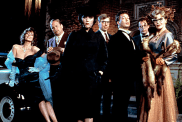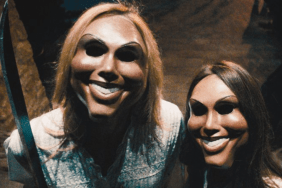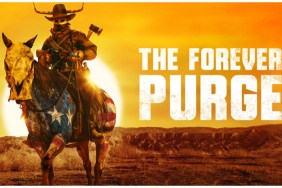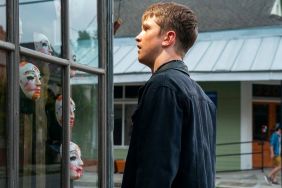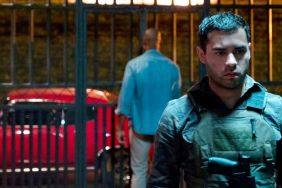
SHOCK reviews the third in the ongoing ultra-violent THE PURGE film franchise.
After two films in whats sure to be a lengthy and lucrative franchise, I realized that I have a love/hate relationship with James DeMonacos THE PURGE. By that I mean that I loved one film and hated the other one.
With his first sleeper success in 2013, DeMonaco took an outlandish, plot hole ridden, but admittedly tasty hook and couldnt deliver anything more exciting than a rote home invasion thriller. Despite its profitability, promise, great cast, and sometimes well directed execution, THE PURGE wasnt a good film by any stretch; a one-off with some good ideas but none of them helping to elevate the material. It was a lacklustre waste of a good cast and a killer concept, but it was a lacklustre waste that made a ton of money on little investment.
On the other hand, DeMonacos 2014 sequel, THE PURGE: ANARCHY, was a big step up. With a larger sandbox to play in (and a bit more money to throw around), DeMonaco was able to leap past his previous effort to deliver an intense, strangely crowd pleasing revenge thriller and action picture that takes place inside the same universe. It was still more or less a riff on established, equally outlandish siege pictures like ASSAULT ON PRECINCT 13 (which DeMonaco wrote the remake 2005 of) and ESCAPE FROM NEW YORK, but it somehow felt fresher. DeMonaco had found the sweet spot for his concept. There was a complexity to everything happening in ANARCHY that was missing from THE PURGE, and considering that DeMonaco wants to give audiences a healthy dose of cultural satire with their shocks and high spots, its the case of a little more care going a very long way.
So for me, there was a bit of trepidation going into DeMonacos third entry in the franchise, THE PURGE: ELECTION YEAR. Not necessarily because DeMonacos last two pictures had a 50/50 split from me, but because there was a fear that the purposefully unsubtle satire of the first two films would come back to overshadow the action and character in this timely entry.
Having said all that, THE PURGE: ELECTION YEAR is everything I had hoped DeMonacos franchise had been in the first place. Its a deliriously fun, sometimes deeply frightening action/horror hybrid with a huge amount of smarts and guts. Its an uncompromising and often purposefully unsubtle allegory designed to make pointed claims about where America is headed as a society.
DeMonaco still hasnt fully embraced the filmmaking craft. He still has a lot to learn about cinematography (with much of the first half of the film shot in such soft focus I thought I had glaucoma), editing action, and figuring out what camera angles look good and which ones dont (although some of the images here are quite poetic when they work). But for the first time, the writer/director knows exactly what kind of franchise he wants THE PURGE to be, and with ELECTION YEAR he goes for broke. Its precisely what he should have done in the first place, and handily the franchise high point thus far.

Set two years after the previous film, returning badass Leo Barnes (Frank Grillo) has taken on a gig as the head of a Secret Service detail for senator and presidential candidate Charlene Roan (Elizabeth Mitchell). Eighteen years prior, Charlene watched in horror on Purge Night as her husband and children were slaughtered in front of her eyes, leaving her the sole survivor. Since that day, Senator Roan has made it her duty to eradicate The Purge. Her stance has strong support among the middle and lower classes, the people victimized most by the yearly event. It has also made her a major target of the ruling party: the New Founding Fathers. In a bid to stop a Roan presidency, the New Founding Fathers revoke a clause in The Purge stating that politicians of a certain status are granted immunity two days before the yearly bloodletting event, making Roan fair game. Not wanting to be seen as someone who runs from a fight, Roan demands to stay home on Purge Night instead of moving to a safe house, a choice Leo strenuously objects to. When Charlene is betrayed and targeted by members of her own security team (and a band of white supremacist mercenaries hired by the New Founding Fathers), Leo is forced to take the senator on a wild run for survival through the streets of inner city Washington D.C.
Theres a lot more going on in DeMonacos third film than just that, but this is the bare bones of the plot. Leo and Charlenes storyline will eventually overlap with the story of a kindly deli owner, Joe Dixon (Mykelti Williamson), whos forced to protect his storefront because the greedy insurance companies (one of the biggest financial supporters of the New Founding Fathers) have astronomically raised the premiums on his Purge coverage. Joe will eventually offer shelter and help to Leo and Charlene, and the trio are helped by an idealistic Mexican immigrant (Joseph Julian Soria) whos grateful for the opportunities America has offered him, but who despises all the hate and violence and Laney Rucker (Betty Gabriel), a once legendary purger who reformed her life and became an equally brave first responder.
DeMonaco answers a lot more what ifs and how do they do xs here than in his last two installments combined, and his cinematic universe seems to fill out more and more with each passing film. An argument could be made that an entire subplot here dealing with an underground resistance movement (led by Edwin Hodge, the only actor to appear in all three films thus far) isnt necessary, and the same message and action sequences could have been done without their involvement, but I understand the need to set up building blocks for future installments. Its the busiest film in the series, but that allows for more of DeMonacos constantly sharpening satire to shine through.

While many films of this nature often take a decidedly right wing stance to defending the sanctity of the American way of life and homeland (INVASION U.S.A., I am looking squarely in your direction), THE PURGE: ELECTION YEAR might as well have a Vote for Hilary sticker on the front, with a defeatist caveat in fine print that says Who cares? Nothing will probably change, anyway. Its so resolvedly democratic that I dont think notoriously right wing producer Michael Bay knew what he was signing up for when he agreed to put his name on this one. In terms of violence and mayhem, its right up Bays alley, but politically, its everything he spends most of his films subtly railing against.
Early on, DeMonaco firmly stands on his political ground by explicitly giving a shout out to the Black Lives Matter movement and staking his claim that wealthy, evangelical white dudes are going to lead America to its doom. The Purge has become so popular that it has inspired foreigners to come over to boost a burgeoning murder tourism economy, but instead of brown skinned minorities or people from the Middle East, those taking advantage of this cottage industry are wealthy white people from Russia or Eastern Europe. Early on, theres a presidential debate between Roan and current president, Minister Edwidge Owens (Kyle Secor), that eerily shadows the democratic gun control sit in that happened just over a week ago. Numerous allusions are made to how Roan needs to win the popular vote from the blue hairs in Florida if shes to have any chance of winning the election. Theres a band of murderous teenage girls (led by a terrifying ad coolly campy Brittany Mirabile) on hand to show how the oppressed can see the purge as a way to get theirs, when really they arent getting anything tangible or useful out of it. These girls look worse than The Crips, who will also come to the aid of the heroes in a time of need. Its expressly a film about the divide between the haves and have nots, and the extent to which the powerful will go to protect their way of life. Its looks at how the rich exploit a crisis, tax the poor, and make them pay for any and all tragedies they suffer long after the pain has passed.
While not every satirical barb hits the intended target with headshot accuracy, DeMonaco knows exactly what he wants to say and how he wants to say it without compromising any of the action. Some might accuse DeMonacos tactics as somewhat backwards, since the action and scares contained within THE PURGE: ELECTION YEAR are designed to be as crowd pleasing and effective as possible. I can feel detractors lining up around the block to say that DeMonacos use of ultraviolence as a means to plead for peace, but sometimes the best way to make a message movie is to be unsubtle about the message if you want people to listen to everything you have to say. Its an unflinching look at a barbaric world that needs to redeem itself before its too late.

Grillo (who if you cant be yourself, or Batman, you should be Frank Grillo) gets to stretch himself a bit here beyond his character from the last film, serving as a perfect action hero. Hes a hard man who has a newfound respect for human life in all its fragility. Its the actors best performance to date. He also gets some assistance and added firepower from a deeply sympathetic turn from Soria and Mitchell, a strong, civic minded Mexican and empowered black female, respectively.
Perhaps best of all, you dont need to have seen THE PURGE or ANARCHY to appreciate or understand ELECTION YEAR. Theres no recap, but it isnt necessary. The energy and fast pace mean its easier to overlook any nagging questions as to how The Purge actually works. Its about the message, the characters, and the action, and it builds to a inspired choice of song to play over the closing credits that finds DeMonaco delivering the final hammer blow to his nail of a film. If the series continues in this direction, Id watch a dozen more of these.
The Purge: Election Year
-
The Purge: Election Year

-
The Purge: Election Year


